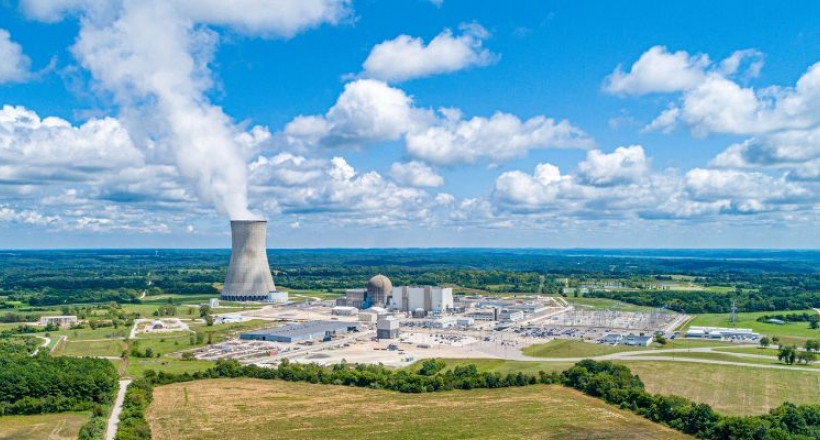Nuclear energy has been a topic of debate for many years, with some believing it to be a safe and clean source of power, while others argue that it is dangerous and harmful to the environment.
In Armenia, nuclear energy has played a significant role in the country's energy mix for decades, with the Metsamor Nuclear Power Plant being the only nuclear power plant in the South Caucasus region. Despite its importance, the plant has faced challenges, including safety concerns and calls for closure.
In this article, we will explore the use of nuclear energy in Armenia, its benefits and challenges, and the future of nuclear power in the country.
A brief overview of nuclear energy in Armenia
Armenia relies heavily on nuclear energy to meet its electricity needs, with the Metsamor Nuclear Power Plant being the country's only operating nuclear power plant. The plant has been in operation since the 1970s and has faced safety concerns and calls for closure, but it remains a significant part of the country's energy mix.
Nuclear energy accounts for over 30% of Armenia's electricity generation, and the country is planning to modernize and expand the Metsamor plant while also pursuing the development of renewable energy sources to diversify its energy mix. Despite ongoing debates about the safety and sustainability of nuclear energy, Armenia's reliance on nuclear power is expected to continue in the near future.
History of Nuclear Energy in Armenia
The history of nuclear energy in Armenia dates back to the Soviet era when the Metsamor Nuclear Power Plant was constructed in 1976. The plant was built to provide electricity to the growing population of Armenia, which had an increasing demand for energy. The plant consists of two VVER-440 reactors with a total installed capacity of 407 MW.
The Metsamor plant was designed to operate for 30 years, but its lifespan has been extended due to Armenia's reliance on nuclear energy to meet its electricity needs.
In 1988, Armenia was hit by a devastating earthquake, which caused widespread destruction and claimed many lives. The Metsamor Nuclear Power Plant was also damaged, leading to its shutdown. After a few years of repairs and upgrades, the plant was reactivated in 1995, despite concerns about its safety and the risk of a potential nuclear accident.
Today, the Metsamor Nuclear Power Plant is responsible for over 30% of Armenia's electricity generation. The plant provides a reliable and constant supply of electricity to the country, and its importance has been highlighted by the recent energy crisis in the region. The plant's two reactors have a combined output of 408 MW and are responsible for the production of about 2,500 GWh of electricity per year.
While nuclear energy has provided Armenia with a stable source of electricity for many years, the safety of the Metsamor Nuclear Power Plant has been a topic of concern. The plant is located in a seismic zone, which increases the risk of a nuclear accident, and it lacks a containment dome, which is considered a safety feature in modern nuclear power plants. However, Armenia is planning to modernize and expand the Metsamor plant to ensure its safety and prolong its lifespan.
Safety Concerns and Accidents
The Metsamor Nuclear Power Plant has been the subject of safety concerns since it was first constructed in the 1970s. The plant's location in a seismically active region has been a particular cause for concern, as Armenia is situated near the intersection of several tectonic plates. In addition, the plant lacks a containment dome, which is a safety feature that is present in modern nuclear power plants.
The safety of the Metsamor plant was called into question in 1988 when a devastating earthquake struck the region. The earthquake, which had a magnitude of 6.8, caused widespread damage and claimed thousands of lives. The Metsamor plant was also damaged, leading to its shutdown. However, the Armenian government decided to reactivate the plant a few years later, despite concerns about its safety and the potential risks to the surrounding population.
To address the safety concerns related to the Metsamor Nuclear Power Plant, Armenia has implemented several measures. The plant has undergone upgrades and repairs to ensure that it is safe to operate, and the government has developed an emergency response plan in case of a nuclear accident. The International Atomic Energy Agency (IAEA) has also provided assistance to Armenia in the areas of safety and security.
Looking to the future, Armenia is planning to modernize and expand the Metsamor plant to ensure its safety and prolong its lifespan. The government has announced plans to construct a new nuclear power plant with modern safety features that will eventually replace the Metsamor plant. The new plant is expected to be built by 2040 and will have a capacity of 1,200 MW. In addition to modernizing its nuclear power infrastructure, Armenia is also investing in renewable energy sources to diversify its energy mix and reduce its reliance on nuclear energy.
Benefits of Nuclear Energy in Armenia
Nuclear energy has played a significant role in meeting Armenia's energy needs and has several benefits for the country. One of the key advantages of nuclear energy is its economic benefits. The Metsamor Nuclear Power Plant provides a reliable and cost-effective source of electricity to the country, reducing the need for expensive imported fossil fuels. The stable electricity supply has also attracted foreign investment, as businesses are more likely to invest in a country with a reliable energy supply.
In addition to the economic benefits, nuclear energy has played a crucial role in meeting Armenia's energy demands. The Metsamor plant currently provides over 30% of Armenia's electricity, and the government is planning to expand the plant's capacity to ensure a stable energy supply for the future. The plant's ability to operate at full capacity, regardless of weather conditions, makes it a reliable source of energy for the country.
Nuclear energy is also a more environmentally friendly source of energy compared to other fossil fuels. The operation of the Metsamor plant produces zero carbon emissions, which contributes to reducing Armenia's carbon footprint. In contrast, the burning of fossil fuels such as coal and oil produces harmful pollutants that have a negative impact on the environment and human health. Additionally, nuclear energy is not subject to the same price volatility as other energy sources, which can be affected by fluctuations in global markets.
While nuclear energy has some potential risks and downsides, Armenia's reliance on nuclear energy has provided the country with significant economic and energy benefits. The government is working to address safety concerns related to the Metsamor plant and is investing in renewable energy sources to diversify its energy mix. As the country continues to develop and grow, nuclear energy will likely remain an important component of Armenia's energy infrastructure.
Public Opinion and Political Debates
Public opinion on the use of nuclear energy in Armenia has been mixed. On one hand, many Armenians see nuclear energy as a necessary component of the country's energy mix, given its reliability and economic benefits. However, there are also concerns about the safety of the Metsamor Nuclear Power Plant and the potential risks to the surrounding population.
Despite these concerns, there has been significant political debate surrounding the Metsamor plant. Some politicians and activists have called for the plant's closure, citing safety concerns and the plant's age. Others have argued that the plant is a vital source of energy for the country and that its closure would have significant economic impacts.
In recent years, the government has announced plans to modernize and expand the Metsamor plant to ensure its safety and prolong its lifespan. However, these plans have been met with opposition from some politicians and activists who argue that the plant should be closed instead of modernized. There have also been calls for greater transparency and public involvement in decision-making related to the plant.
Overall, the debate over the Metsamor Nuclear Power Plant reflects the complex issues surrounding the use of nuclear energy in Armenia. While the plant has provided significant economic and energy benefits for the country, there are also legitimate safety concerns that must be addressed. As Armenia continues to develop and grow, it will be important for the government to balance the need for reliable energy with the safety and well-being of its citizens.
The Future of Nuclear Energy in Armenia
The future of nuclear energy in Armenia is closely tied to the government's plans for modernizing and expanding the Metsamor Nuclear Power Plant. In recent years, the government has announced plans to modernize the plant to ensure its safety and prolong its lifespan. This includes upgrading the plant's equipment and infrastructure, as well as improving safety measures and emergency response plans.
In addition to modernizing the Metsamor plant, the government is also exploring ways to diversify the country's energy mix. This includes investing in renewable energy sources such as solar and wind power. The government has set a goal of increasing the share of renewable energy in the country's energy mix to 30% by 2025. To achieve this goal, the government is offering incentives to businesses and households to invest in renewable energy, as well as promoting the development of new renewable energy projects.
The government has also expressed interest in building a new nuclear power plant in Armenia in the future. This would provide additional energy capacity for the country and help to further reduce Armenia's reliance on imported fossil fuels. However, plans for a new plant are still in the early stages, and the government has stated that any new plant would need to meet stringent safety requirements and involve a high level of public involvement and transparency.
Overall, the future of nuclear energy in Armenia is likely to involve a combination of modernizing the existing Metsamor plant, investing in renewable energy sources, and potentially building a new nuclear plant in the future. As the country continues to develop and grow, it will be important for the government to balance the need for reliable energy with the safety and well-being of its citizens.
In conclusion
Nuclear energy has played a significant role in meeting Armenia's energy demands for decades, with the Metsamor Nuclear Power Plant being the only nuclear power plant in the South Caucasus region. Despite concerns surrounding safety, the economic benefits of nuclear energy for the country cannot be ignored. However, with plans to modernize and expand the Metsamor Nuclear Power Plant and diversify the country's energy mix with renewable sources, the future of nuclear energy in Armenia remains uncertain. As the country moves towards a cleaner, more sustainable future, the role of nuclear energy in the energy mix will continue to be a topic of debate.

